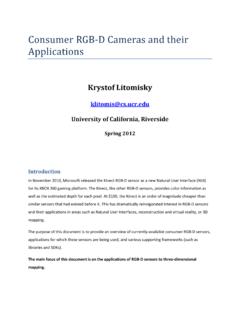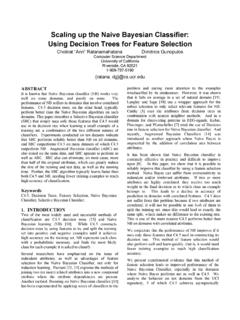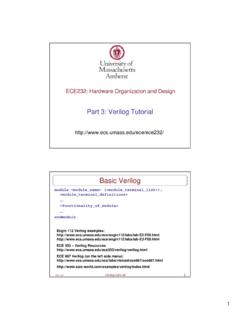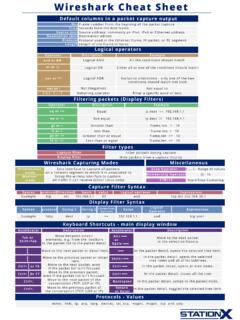Transcription of Introduction to Socket Programming
1 Introduction to Socket ProgrammingPart I : TCP Clients, Servers; Host informationKeywords: sockets , client-server, network Programming - Socket functions, OSI layering, byte-orderingOutline:1.) Introduction2.) The Client / Server Model3.) The Socket Interface and Features of a TCP connection4.) Byte Ordering5.) Address Structures, ports , Address conversion functions6.) Outline of a TCP Server7.) Outline of a TCP Client8.) Client-Server communication outline9.) Summary of Socket Functions**NOTE**This Introduction is not intended to be a thorough and in depth coverage of the sockets API but only togive a general outline of elementary TCP Socket usage. Please refer to Richard Stevens book : UnixNetwork Programming Volume 1 for details about any of the functions covered here, and also use theonline man pages for more specific details about each ) IntroductionIn this Lab you will be introduced to Socket Programming at a very elementary level.
2 Specifically, wewill focus on TCP Socket connections which are a fundamental part of Socket Programming since theyprovide a connection oriented service with both flow and congestion control. What this means to theprogrammer is that a TCP connection provides a reliable connection over which data can be transferredwith little effort required on the programmers part; TCP takes care of the reliability, flow control,congestion control for you. First the basic concepts will be discussed, then we will learn how toimplement a simple TCP client and ) The Client / Server ModelIt is possible for two network applications to begin simultaneously, but it is impractical to require , it makes sense to design communicating network applications to perform complementarynetwork operations in sequence, rather than simultaneously. The server executes first and waits toreceive; the client executes second and sends the first network packet to the server.
3 After initial contact,either the client or the server is capable of sending and receiving ) The Socket Interface and Features of a TCP connectionThe OSI Layers:The Internet Layers:The Internet does not strictly obey the OSI model but rather merges several of the protocols layerstogether. Wrapping(Encapsulation)UnWrappingWhere is the Socket Programming interface in relation to the protocol stack?Features of a TCP connection: Connection Oriented Reliability1. Handles lost packets2. Handles packet sequencing3. Handles duplicated packets Full Duplex Flow Control Congestion ControlTCP versus UDP as a Transport Layer Protocol:TCPUDPR eliable, guaranteedUnreliable. Instead, prompt delivery in applications that require safety gurantee. ( applications.)Used in media applications. (eg. video orvoice transmissions.)Flow control, sequencing of packets, flow or sequence control, user must handlethese byte stream as unit of transfer.
4 (stream sockets )Uses datagrams as unit of transfer.(datagram sockets )Allows to send multiple packets with a single two-way data exchange, once the connection isestablished. (full-duplex)Allows data to be transferred in one directionat once. (half-duplex) Telnet uses stream sockets .(everything you write on one side appears exaclt in sameorder on the other side) TFTP (trivial file transfer protocol) usesdatagram three-way Handshake: (Read pg 37 Stevens) sockets versus File I/OWorking with sockets is very similar to working with files. The Socket () and accept() functions bothreturn handles (file descriptor) and reads and writes to the sockets requires the use of these handles (filedescriptors). In Linux, sockets and file descriptors also share the same file descriptor table. That is, ifyou open a file and it returns a file descriptor with value say 8, and then immediately open a Socket , youwill be given a file descriptor with value 9 to reference that Socket .
5 Even though sockets and files sharethe same file descriptor table, they are still very different. sockets have addresses associated with themwhereas files do not, notice that this distinguishes sockets form pipes, since pipes do not have addresseswith which they associate. You cannot randomly access a Socket like you can a file with lseek(). Socketsmust be in the correct state to perform input or ) Byte OrderingPort numbers and IP Addresses (both discussed next) are represented by multi-byte data types which areplaced in packets for the purpose of routing and multiplexing. Port numbers are two bytes (16 bits) andIP4 addresses are 4 bytes (32 bits), and a problem arises when transferring multi-byte data types betweendifferent architectures. Say Host A uses a big-endian architecture and sends a packet across thenetwork to Host B which uses a little-endian architecture. If Host B looks at the address to see if thepacket is for him/her (choose a gender!
6 , it will interpret the bytes in the opposite order and will wronglyconclude that it is not his/her packet. The Internet uses big-endian and we call it the network-byte-order,and it is really not important to know which method it uses since we have the following functions toconvert host-byte-ordered values into network-byte-ordered values and vice versa:To convert port numbers (16 bits):Host -> Networkunit16_t htons( uint16_t hostportnumber )Network -> Hostunit16_t ntohs( uint16_t netportnumber )To convert IP4 Addresses (32 bits):Host -> Networkunit32_t htonl( uint32_t hostportnumber )Network -> HostUnit32_t ntohl( uint32_t netportnumber )5.) Address Structures, ports , Address conversion functionsOverview of IP4 addresses:IP4 addresses are 32 bits long. They are expressed commonly in what is known as dotted decimalnotation. Each of the four bytes which makes up the 32 address are expressed as an integer value(0 255) and separated by a dot.
7 For example, is an example of an IP4 address in dotteddecimal notation. There are conversion functions which convert a 32 bit address into a dotted decimalstring and vice versa which will be discussed times though the IP address is represented by a domain name, for example, Severalfunctions described later will allow you to convert from one form to another (Magic provided by DNS!).The importance of IP addresses follows from the fact that each host on the Internet has a unique IPaddress. Thus, although the Internet is made up of many networks of networks with many different typesof architectures and transport mediums, it is the IP address which provides a cohesive structure so that atleast theoretically, (there are routing issues involved as well), any two hosts on the Internet cancommunicate with each : sockets are UNIQUELY identified by Internet address, end-to-end protocol, and port is why when a Socket is first created it is vital to match it with a valid IP address and a port our labs we will basically be working with TCP are software objects to multiplex data between different applications.
8 When a host receives apacket, it travels up the protocol stack and finally reaches the application layer. Now consider a userrunning an ftp client, a telnet client, and a web browser concurrently. To which application should thepacket be delivered? Well part of the packet contains a value holding a port number, and it is this numberwhich determines to which application the packet should be when a client first tries to contact a server, which port number should the client specify? For manycommon services, standard port numbers are 0 1023, are reserved and servers or clients that you create will not be able to bind to these portsunless you have root 1024 65535 are available for use by your programs, but beware other network applications mayberunning and using these port numbers as well so do not make assumptions about the availability ofspecific port numbers. Make sure you read Stevens for more details about the available range of portnumbers!
9 Address Structures: Socket functions like connect(), accept(), and bind() require the use of specifically defined addressstructures to hold IP address information, port number, and protocol type. This can be one of the moreconfusing aspects of Socket Programming so it is necessary to clearly understand how to use the socketaddress structures. The difficulty is that you can use sockets to program network applications usingdifferent protocols. For example, we can use IP4, IP6, Unix local, etc. Here is the problem: Eachdifferent protocol uses a different address structure to hold its addressing information, yet they all use thesame functions connect(), accept(), bind() etc. So how do we pass these different structures to a givensocket function that requires an address structure? Well it may not be the way you would think it shouldbe done and this is because sockets where developed a long time ago before things like a void pointerwhere features in C.
10 So this is how it is done:There is a generic address structure: struct sockaddrThis is the address structure which must be passed to all of the Socket functions requiring an addressstructure. This means that you must type cast your specific protocol dependent address structure to thegeneric address structure when passing it to these Socket specific address structures usually start with sockaddr_ and end with a suffix depending on thatprotocol. For example:struct sockaddr_in (IP4, think of in as internet)struct sockaddr_in6(IP6)struct sockaddr_un(Unix local)struct sockaddr_dl(Data link)We will be only using the IP4 address structure: struct once we fill in this structure with the IP address, port number, etc we will pass this to one of our socketfunctions and we will need to type cast it to the generic address structure. For example:struct sockaddr_in myAddressStruct;//Fill in the address information into myAddressStruct here, (will be explained indetail shortly)connect(socket_file_descriptor, (struct sockaddr *) &myAddressStruct,sizeof(myAddressStruct) );Here is how to fill in the sockaddr_in structure:struct sockaddr_in{sa_family_t sin_family /*Address/Protocol Family*/ (we ll use PF_INET)unit16_t sin_port /* 16-bit Port number --Network Byte Ordered--*/struct in_addr sin_addr/*A struct for the 32 bit IP Address */unsigned char sin_zero[8]/*Just ignore this it is just padding*/};struct in_addr{unit32_t s_addr /*32 bit IP Address --Network Byte Ordered-- */}.













